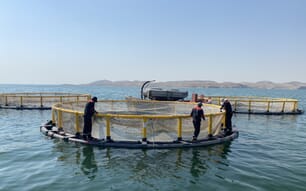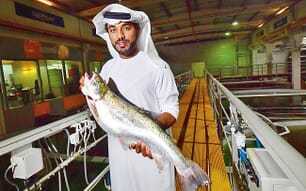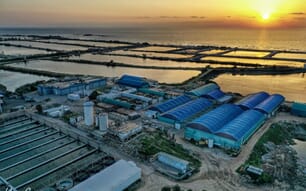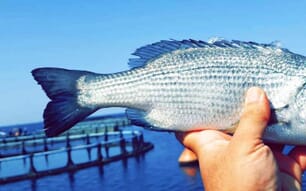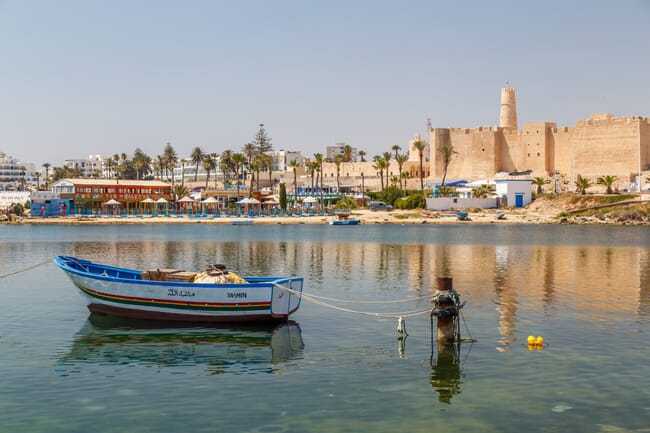
Tunisia's main marine aquaculture area is located in the Governorate of Monastir
We spoke with several local experts to discuss the most important hurdles and opportunities that will bring the local aquaculture sector to the international stage.
As with most residents of the Mediterranean region, fish and other seafood play an important role in the diet of Tunisians and they eat an average of 13.2 kg seafood per year (FAO 2019). The dwindling quantities of wild catch, combined with an increase in demand for seafood, has consequently led to a substantial growth in the aquaculture sector. By now, 16 percent of the production of aquatic products comes from aquaculture and the sector provides over 2,000 jobs (SwitchMed 2021).
The local aquaculture industry started developing in the 1960s with a shellfish farm established by the government. In the 1980s, the first private hatchery of European seabass (Dicentrarchus labrax) and gilthead seabream (Sparus aurata) was established. Since 2003, some farms are engaged in the fattening of Atlantic bluefin tuna (Thunnus thynnus). Additionally there are farms producing shellfish, mostly Mediterranean mussel, and Spirulina. Inland farming of freshwater species includes tilapia, carps, pike-perch and flathead grey mullet (FAO 2019, Cherif et al. 2011).
In recent years, the culture of seabass and seabream in floating and submersible cages at offshore farms has grown significantly. The production of these two species represent 96 percent of the aquaculture production in Tunisia. The country currently has 25 marine aquaculture farms, each producing between 400 and 3,500 tonnes a year. Total aquaculture production was around 22,000 tonnes in 2018, of which over 20,000 tonnes consisted of marine species.
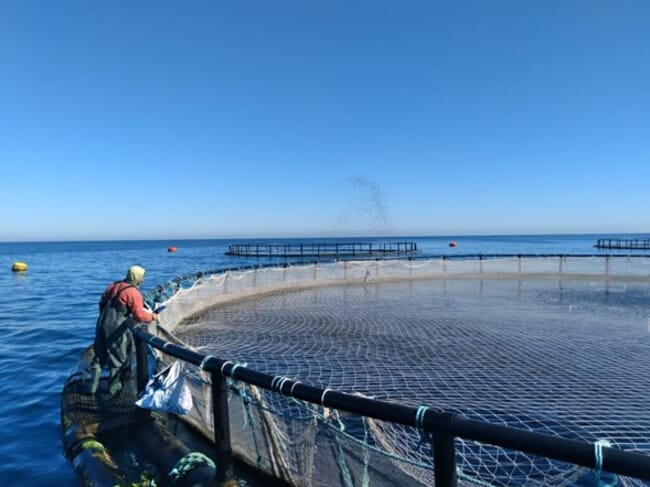
Seabass and seabream represent 96 percent of Tunisia's aquaculture output © Porto Farina
Strengths of Tunisian aquaculture
Tunisia has many suitable areas for aquaculture thanks to its long coastline and large marine domain. The main marine aquaculture area is located in the Governorate of Monastir, in the eastern portion of the country. Freshwater fish are mainly cultured in dammed areas in the north and centre of the country.
“In addition to the many suitable sites, the country has the right climate for aquaculture of Mediterranean species, and low labour and energy costs,” says Houssem Sghaier, hatchery manager at the Medimegh Aquaculture Group.
Dr Mohamed Azaza, head of the aquaculture department at the Institut National des Sciences et Technologies de la Mer (INSTM) explains: “In the south of the Mediterranean Sea, water has the optimal temperature for the culture of seabream and seabass and here you can reach commercial size faster than in northern sites”.
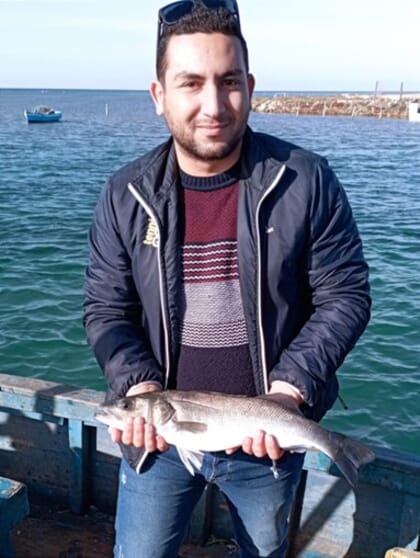
Despite its vast marine resources, Tunisia's aquaculture sector faces a number of hurdles
Challenges for Tunisian aquaculture
Dr Azaza adds that despite these splendid opportunities there are also four main challenges facing the sector:
- Most inputs for aquaculture are imported, which affects the economic sustainability of the sector. There is no self-sufficiency in the production of feed and fingerlings. There are three feed manufacturers in Tunisia supporting the sector, however close to 50 percent of feed is imported because the feed producers operate far below their capacity due to a lack of raw materials available. There are only two hatcheries in the country for seabream and seabass, which together supply only 13 percent of the required juveniles; the remainder is imported. For example, the Medimegh Aquaculture Group imports fingerlings and feed at higher costs, and often with unfavourable exchange rates. On top of this, it is not easy to import goods due to complicated administrative procedures;
- Social acceptability of the aquaculture sector is low. The integration of aquaculture in coastal areas needs to be managed by allocating zones for aquaculture to reduce conflict with other sectors – such as fisheries, tourism and maritime navigation;
- Tunisian farmers face significant problems with diseases, especially viral nervous necrosis (VNN) in European seabass. To reduce mortalities and occurrence of diseases, the biosecurity of Tunisian aquaculture should be improved;
- Innovative technologies and tools, such as artificial intelligence or cameras for cage monitoring, are not yet used, due to their high investment costs and the fact that farmers are unaware of government incentives that support these types of investments.
For Sghaier the main problem is the low selling price at local markets.
“Sometimes we sell for prices lower than the production costs in order to pay back loans,” he explains.
Most of the aquaculture production is sold at local markets, although recently farmers have been able to gain ground in international markets too.
Khaled Ridene, technical manager of Porto Farina farm, confirms this. “The very high costs of investment for infrastructure, feed and fry combined with the stagnation of selling prices result in a shrinking profit margin,” he notes.
Therefore, more government support is needed to tackle these challenges and create a sustainable and profitable aquaculture sector in Tunisia.
Government initiatives

Aquaculture in Tunisia needs more government support to meet its economic and sustainability goals © Porto Farina
The government plans to develop the sector further by supporting operators through financial incentives such as tax benefits and subsidies for fuel and infrastructure. The government also provides assistance to the sector through the Technical Centre for Aquaculture (CTA) of the Ministry of Agriculture, Water Resources and Maritime Fisheries. The centre forms the link between scientific research and the industry. It operates five aquaculture demonstration sites across the country where it organises training sessions and conducts research on new species and new breeding techniques.
To support the aquaculture sector with research, development projects and technical advice the government has established two research institutes; INSTM and Institut Supérieur de Biotechnologie de Monastir (ISBM). ISBM provides academic courses in the field of aquaculture whereas INSTM conducts research programmes related to the sea and its resources. The Laboratory of Aquaculture at INSTM was created in 1999. The laboratory aims to develop scientific and technical tools that contribute to the optimisation of the management of aquaculture production, ensuring a compromise between the need to increase production and making the sector more sustainable.
As of 2014, the government has set up a health and zoosanitary monitoring system for aquaculture.
“Obtaining the approval of the General Directorate of Fisheries and Aquaculture is essential for any operator engaged in the sector,” says Ridene, who believes that his scheme should contribute to increasing biosecurity and sustainability in the sector.
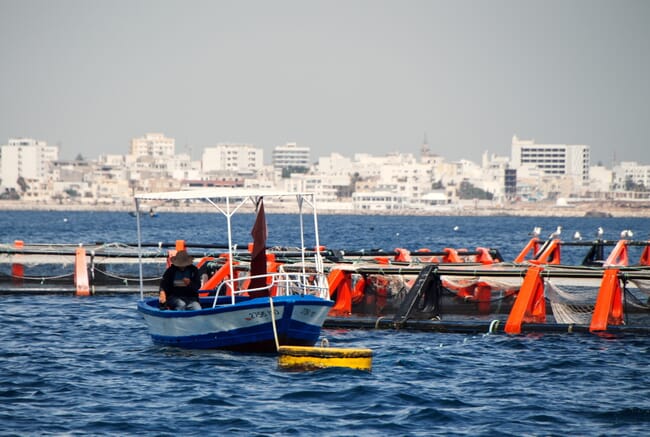
The Tunisian government has started research and development initiatives for the sector
Research and development
There are several international grants available for the development and application of innovations and farm improvements. Dr Azaza has been involved in several EU-funded programmes. One of them is SwitchMed, a project implemented by the United Nations Industrial Development Organisation (UNIDO) with the aim to support the development of sustainable aquaculture in the country. The project analysed the value chain of marine aquaculture and identified bottlenecks in the sector.
In a follow-up project, SwitchMed II, SMART technologies to improve the feed conversion ratio by monitoring biomass and feed intake with a camera system are being piloted. Distribution of feed can be adjusted to the needs of the fish and feed losses can be reduced. The system can be accessed on a mobile device, so people working on the cage can access it directly and make the necessary adjustments. The goals of this SMART technology is to improve farm economics and reduce impact on the environment; two key factors to improve the sustainability of local fish farms, and also contribute to improving their financial performance.
The future
Sghaier believes that new hatcheries and feed factories should be prioritised to ensure self-sufficiency of the aquaculture sector in Tunisia and decrease production costs.
“The government should promote the local production of fry and fish feed and our country needs legislation that regulates the sector,” agrees Ridene.
Dr Azaza also wishes to see more organised and integrated activities to ensure fewer conflicts with other sectors and improve farm performance and fish quality. Farms should cooperate and production systems should be improved by implementing smart technologies and integrated multi-trophic aquaculture (IMTA) systems, where the culture of fish is combined with production of shellfish such as mussels and oysters. According to Dr Azaza, shellfish should be prioritised over diversification of finfish.
“They have been talking about diversification for 30 years but on the market we still have the same species. Species that do not need feeds will significantly reduce the impacts of fish farming and increase overall profitability,” he argues.
Overcoming these hurdles provides plenty of opportunities for both local and foreign investors and we are confident that we will be able to bring you more positive updates on the Tunisian aquaculture in the near future. Stay tuned.

